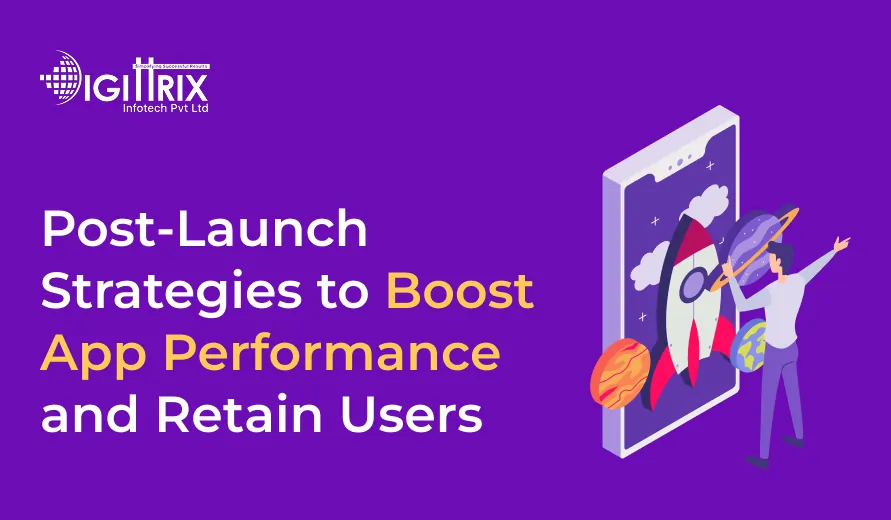Post-launch app strategies, such as monitoring performance, updates, user feedback, and push notifications, help retain users and ensure the smooth operation of mobile apps.
Highlights
An enthusiastic developer and skilled business management expert with over a decade of experience in the field

Launching a mobile app is just the beginning of a long journey. Many developers and companies focus heavily on pre-launch tasks like designing, coding, and testing. But the real challenge begins after the app goes live. Post-launch strategies are crucial to maintaining the app’s performance, keeping users satisfied, and encouraging long-term engagement. This article will explore practical ways any business can ensure its mobile app succeeds after launch.
Want to boost sales through mobile? Check out Digittrix’s mobile app strategy tips and grow your business!
Once your app is live, it is crucial to monitor its performance continuously. Monitoring includes checking for app crashes, slow loading times, and other technical issues that could frustrate users. Many app development companies recommend using analytics tools to track performance metrics such as user retention rates, session durations, and feature usage. This helps identify weaknesses and allows for timely improvements and fixes.
For example, an Android app developer can monitor memory usage and battery life to ensure the app runs smoothly on different devices. Similarly, an iOS app developer should track app responsiveness and compatibility with various iPhone and iPad models. By regularly observing performance, developers can fix issues before they negatively affect users' experience.
User feedback is a crucial source of information about how your app performs in real-world situations. Encouraging users to share their feedback helps developers understand their expectations, identify frustrations, and make suitable improvements. Feedback can be collected through in-app surveys, app store reviews, or direct email communication.
Custom app development teams can implement automated prompts within the app to request reviews after specific milestones or periods of usage. This method provides genuine insights without overwhelming the user. Acting quickly on user suggestions also helps retain users, as they feel their opinions are valued.
Updating an app involves more than just fixing bugs; it also includes making small improvements and ensuring compatibility with new operating system versions. Regular updates demonstrate to users that the app is actively maintained and that the developers are dedicated to quality. Updates should be thoughtfully planned to include essential performance fixes and minor enhancements that boost overall functionality and usability.
For apps developed using on-demand app development services, updates may include enhancing response times, fixing bugs, or resolving security vulnerabilities. Regular maintenance ensures that both Android and iOS applications operate smoothly and reduces the likelihood of user issues.
Loading speed greatly impacts user retention. Users frequently abandon apps that load slowly. Therefore, optimizing app performance is essential to keep users engaged. Techniques to enhance loading times include compressing images, reducing unnecessary code, and implementing efficient data management methods.
Mobile app development teams often focus on creating lightweight apps that run smoothly even on older devices. An Android app developer might concentrate on optimizing for various screen sizes and memory limits, while an iOS developer may prioritize balancing performance and graphics quality. Faster load times directly enhance user experience and increase retention rates.
Push notifications can remind users about the app and encourage them to return regularly. However, they should be used carefully to avoid overwhelming users. Sending relevant updates or personalized reminders keeps users engaged without causing annoyance or fatigue.
For example, custom app development solutions often allow segmentation of users based on their preferences and behaviors. Targeted notifications, such as reminders about new features or promotions, can help users feel that the app is useful and responsive to their needs. When used effectively, push notifications are a powerful tool for keeping users engaged and active.
A smooth onboarding process is essential for keeping users engaged during the first few days after installation. A complicated or confusing onboarding experience might cause users to abandon the app before experiencing its full benefits. Simple registration steps, clear instructions, and guided tours of app features can help users better understand the app quickly.
On-demand app development companies often create onboarding modules that emphasize clarity and user-friendliness. Android and iOS app developers should focus on the app flow, ensuring users can easily access the main features. Clear onboarding improves first impressions and encourages users to keep using the app.
Security is a vital factor that influences user trust. Post-launch strategies should include monitoring security vulnerabilities and safeguarding user data. Implementing secure authentication methods, encrypting sensitive information, and updating security protocols help reduce the risk of breaches.
Mobile app development companies often provide ongoing security support to keep apps safe. Android app developers may focus on permissions management, while iOS developers check for vulnerabilities during system updates. A secure app encourages users to engage regularly, knowing their information is safe and secure protected.
Understanding how users interact with your app reveals opportunities for improvement. Analyzing user behavior involves tracking which features are most popular, how long users stay in the app, and when they exit. This data helps developers prioritize updates and enhance the user experience.
Custom app development teams can use heatmaps, session recordings, and analytics dashboards to effectively track user behavior. Android and iOS app developers can then analyze this data to identify bottlenecks or areas where users struggle. By understanding user actions, developers can make informed decisions that help retain users over time.
Providing easy access to support boosts user satisfaction. In-app support features, such as live chat, FAQs, or automated help sections, help users resolve issues without leaving the app. Fast assistance reduces frustration and increases the likelihood of continued use.
On-demand app development services typically include support systems that respond quickly and offer accurate assistance. Android and iOS app developers should ensure support features are intuitive and easy to access. Good support builds trust and encourages long-term relationship engagement.
Loyalty programs are an effective way to keep users engaged. Rewarding users for consistent activity, referrals, or completing specific tasks encourages them to keep coming back. These programs can include points, badges, or exclusive content available only to active users.
Mobile app development companies often include gamification features that make loyalty programs engaging and motivating. Android and iOS app developers can track progress and offer personalized rewards, boosting user retention. Recognizing user activity fosters a sense of value and connection with the app.
App store optimization (ASO) continues even after launching the app. Well-crafted descriptions, relevant keywords, and high-quality screenshots improve discoverability, encouraging new users to download the app. Regularly updating app store listings to highlight improvements or new features also signals ongoing development efforts.
On-demand app development companies often assist clients in maintaining strong app store pages. Android app developers focus on optimizing for Google Play, while iOS app developers handle their App Store presentation. Clear and accurate app listings attract users, fostering growth and retention.
Monitoring performance metrics is essential for ongoing improvement. Metrics such as daily active users, churn rate, session length, and retention rate offer a thorough view of the app’s health. These metrics inform decisions about updates and post-launch strategies.
Custom app development teams focus on regular reporting to track these metrics. Android and iOS app developers can use dashboards to visualize trends and identify potential issues early. Monitoring performance helps ensure that actions meet user expectations and business objectives.
Post-launch planning should include preparations for growth. Apps must handle increased user loads and maintain performance. Scalability considerations involve server capacity, database management, and cloud infrastructure. Proper planning ensures the app remains functional even as the user base expands.
Mobile app development companies recommend scalable architecture during post-launch assessments. Android and iOS app developers work with backend teams to ensure responsiveness and prevent crashes. Scalable apps provide a reliable experience and support long-term use retention.
Keeping app content fresh is another way to retain users. Regularly updating content like articles, videos, product info, or user interface features keeps the app engaging. Users are more likely to return when there is something new to see or experience.
On-demand app development services often include support for content management systems within apps. Android and iOS app developers collaborate closely with content teams to ensure updates are delivered smoothly. Updated content helps keep the app relevant and maintains user engagement.
Want to boost your app’s speed and user satisfaction? Check out Digittrix’s mobile app performance tips and make your app smoother!
The post-launch phase is crucial for any app’s long-term success. Ongoing monitoring, regular updates, and understanding user behavior establish a foundation for effective post-launch strategies. By taking thoughtful actions, mobile app development teams can sustain performance, satisfy users, and foster ongoing engagement. Custom app development, whether for Android or iOS, shouldn't end at deployment; it requires continuous attention and optimization to keep the app competitive and useful. Using these post-launch strategies, businesses can build loyal users and a stable, growing app ecosystem.
By applying these strategies, an app development company can greatly enhance its ability to retain users and promote long-term growth. From tracking performance to updating content and supporting users, each method helps create a smooth and enjoyable user experience.
Ultimately, post-launch management isn't just about fixing problems; it’s about creating an environment where users feel valued and want to keep returning, ensuring the app’s long-term success in a competitive market landscape.
Launching a mobile app is just the start; maintaining its performance and keeping users engaged are crucial for long-term success. At Digittrix, we concentrate on post-launch strategies that ensure your app operates smoothly, retains users, and remains competitive.
Whether your app was built through on-demand development, needs updates from an Android or iOS developer, or requires ongoing development services, our team offers practical solutions to monitor performance, implement improvements, and maintain user satisfaction.
With extensive experience in mobile and custom app development, Digittrix helps businesses track performance metrics, gather user feedback, deliver timely updates, and implement strategies that keep users engaged. Our approach balances efficiency and quality to ensure your app remains reliable and appealing.
If you want to maximize your app’s potential and build a loyal user base, contact Digittrix today. Call +91 8727000867 or email digittrix@gmail.com to discuss post-launch strategies and keep your app performing at its best.

Do you need help in Mobile App development?




Join over 1500+ businesses we've already helped!
Key strategies include monitoring performance, gathering user feedback, regular updates, improving loading speed, and providing in-app support.
Monitoring helps detect crashes, slow load times, or bugs early, ensuring a smooth experience that keeps users engaged.
Retention can be achieved through regular updates, loyalty programs, user feedback implementation, and targeted push notifications.
While core strategies are similar, Android app developers focus on device compatibility and memory usage, while iOS app developers emphasize responsiveness and OS updates.

©2025Digittrix Infotech Private Limited , All rights reserved.